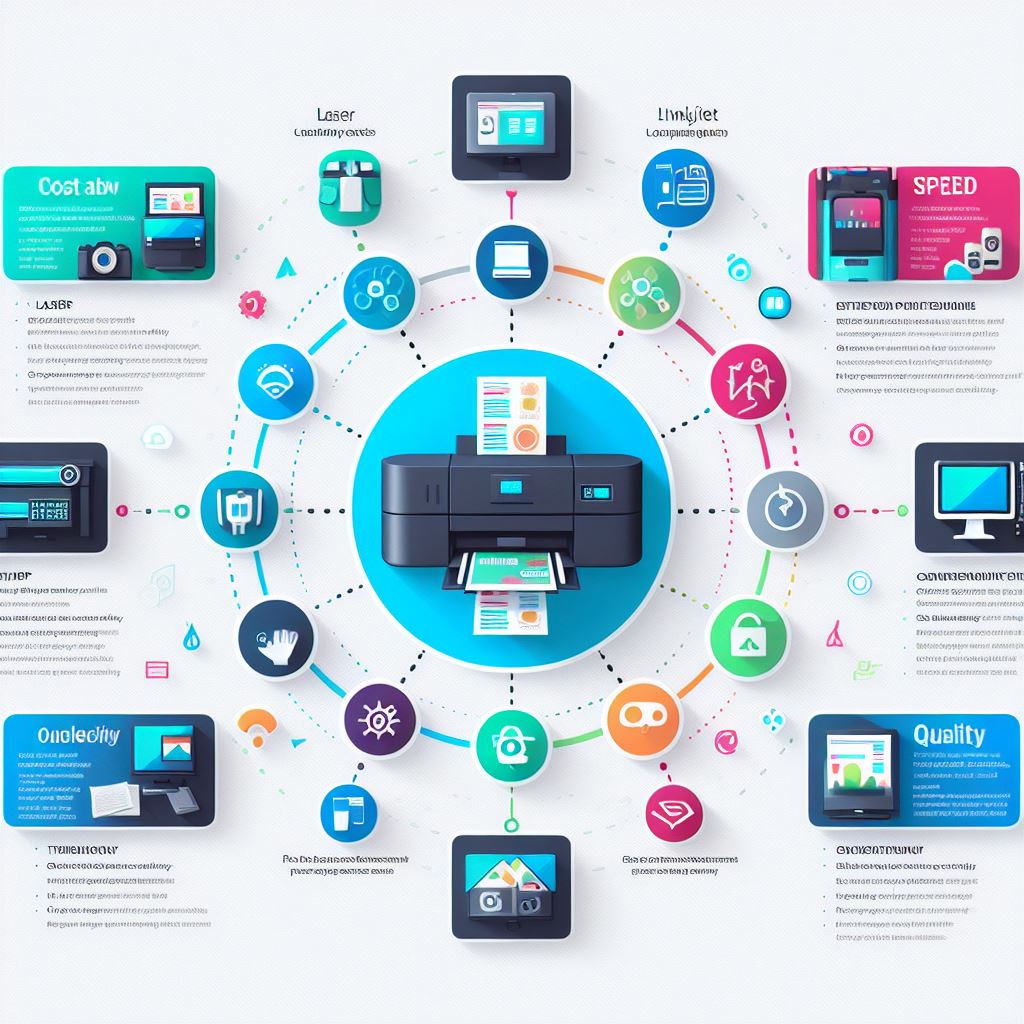Choosing the right printer is essential for boosting both productivity and creativity. Whether for business or personal use, a good printer can significantly improve efficiency and deliver top-notch prints. Here are some key factors to simplify your decision-making process:
1. Printing Needs:
- Assess the volume and quality of prints required.
- Determine if you need a small, medium, or high-capacity printer.
- Consider whether color and high-quality output are necessary.
2. Costs:
- Evaluate both upfront and long-term costs.
- Factor in cartridge replacements, maintenance, and energy consumption.
- Be cautious of cheaper upfront costs that might result in higher long-term expenses.
3. Maintenance:
- Check for maintenance requirements.
- Evaluate the likelihood of issues like jamming.
- Opt for a printer with minimal maintenance needs.
4. Printing Speed:
- Decide if a fast printer is essential for your office or personal use.
- Consider your printing speed requirements based on your workflow.
5. Printing Quality:
- Determine the primary purpose of your prints.
- If sharing documents externally, prioritize high printing quality for a positive impression.
- Balance quality for internal documents based on your needs.
6. Ideal Use Cases:
- Different printers excel in specific applications.
- Inkjet printers are versatile and popular for small businesses.
- Laser printers are faster and provide sharper edges and crisper images.
- SOHO multifunction inkjet photo printers are perfect for photo printing with up to 6 different inks.
By considering these factors, you can confidently choose a printer that aligns with your specific needs, enhancing both your productivity and creativity.
Types of Printers
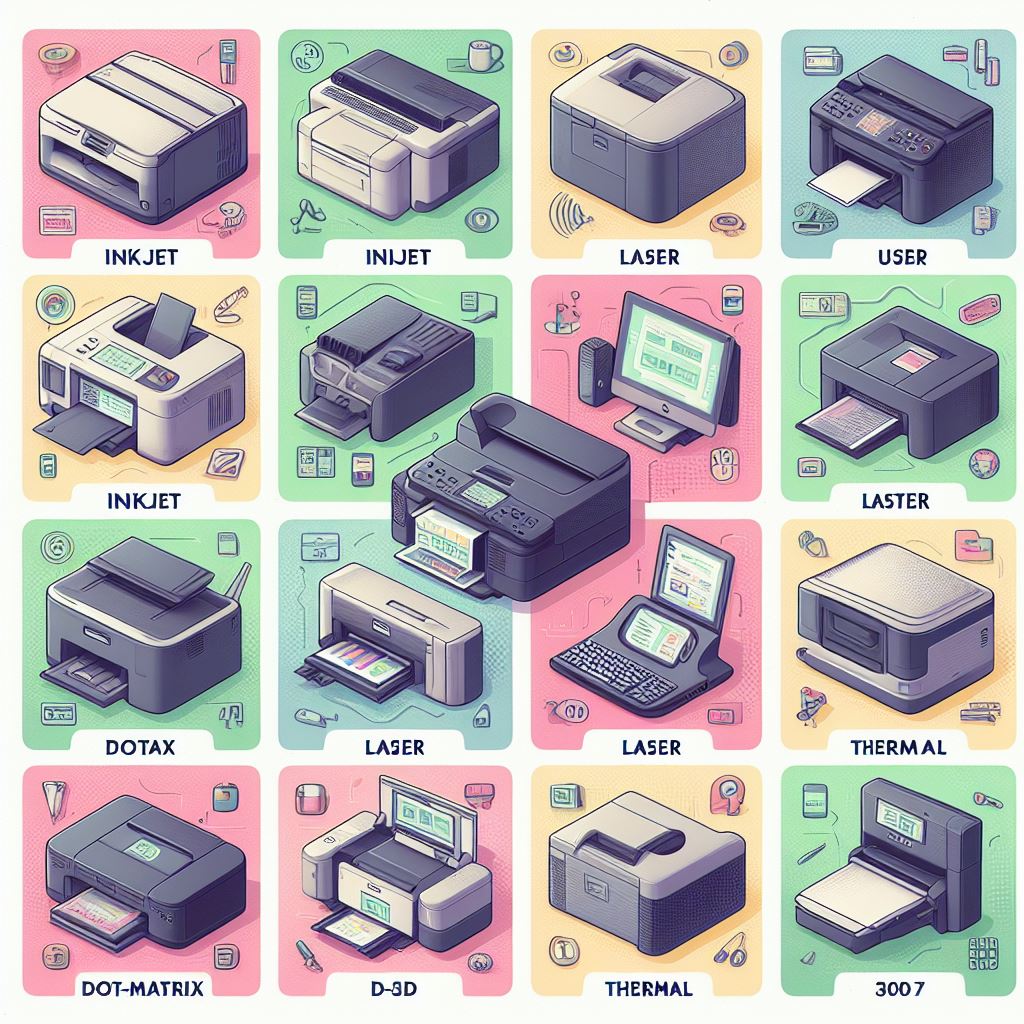
1. Inkjet Printers
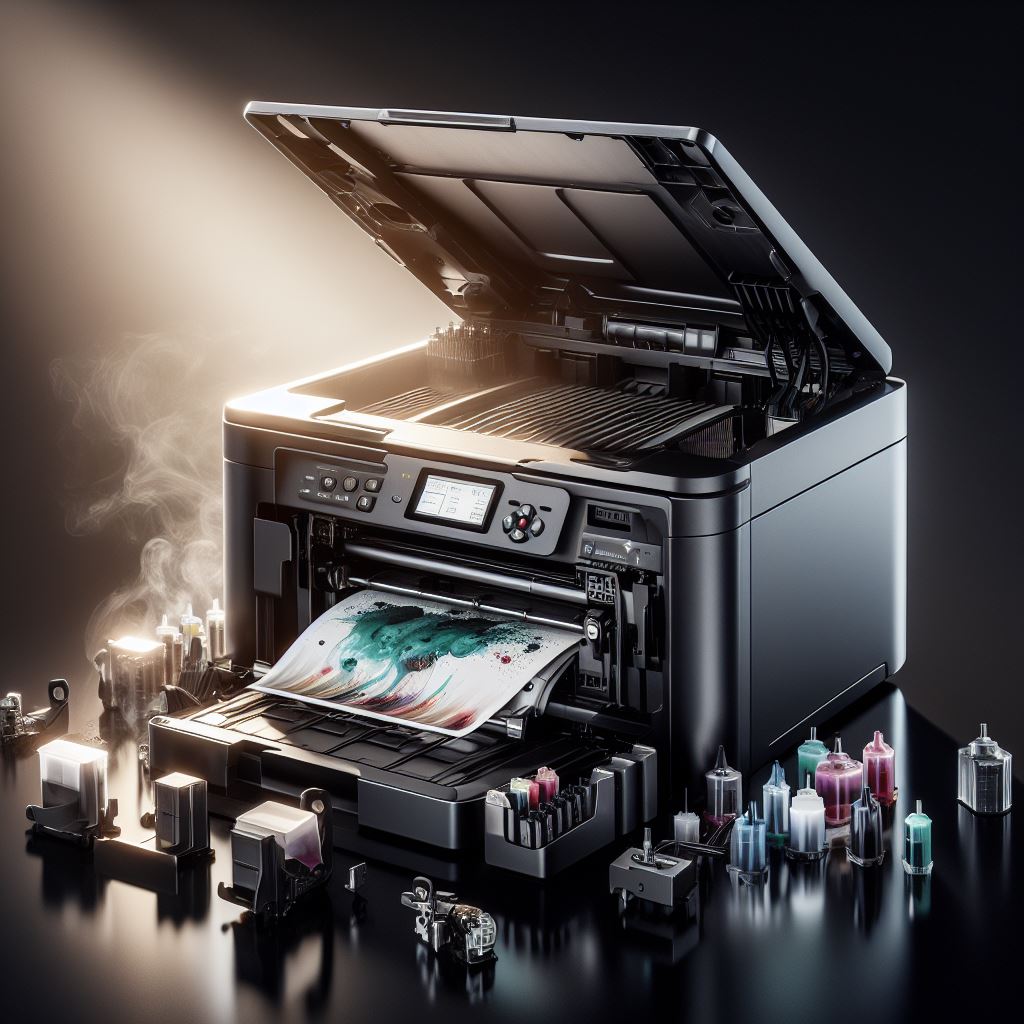
Inkjet printers operate by shooting tiny droplets of ink onto paper as it glides through the print head. Picture it like a microscopic ink spray painting characters and images. This print head is armed with numerous minuscule nozzles, charmingly known as jets, orchestrating the colorful ink dance onto the paper.
Why do we love inkjet printers? Because they're the multitaskers of the printing world. From bringing your cherished photos to life to handling everyday printing needs at home, inkjet printers are your trusty sidekicks for various applications. They make creativity and convenience look effortlessly cool!
Ideal Use Cases
Inkjet printers are ideal for the following use cases:
- Photo Printing:
- Ideal for photography enthusiasts and professionals.
- Produces high-quality, vibrant photo prints.
- General Home Use:
- Versatile and cost-effective for everyday printing.
- Perfect for households, handling text documents, graphics, and occasional photo printing.
Pros and Cons
Pros
- Ideal for Creative Projects:
- Perfect for photo and graphic printing.
- Ideal for both creative projects and professional photography.
- Versatile Paper Options:
- Can print on various paper types, such as inkjet paper, matte and glossy photo paper, and textured stationery.
- Provides flexibility for different printing needs.
- Cost-Effective Long-Term:
- Reduced long-term cost compared to toner cartridges.
- Economical choice for specific printing needs.
Cons
- Print Quality Variation:
- Print quality can vary among inkjet printers.
- Influenced by factors like printhead design, printer driver, and ink quality.
- Cost Consideration for High-Volume Printing:
- Not as cost-effective for high-volume printing compared to laser printers.
- Especially true for text documents with few colors.
2. Laser Printers
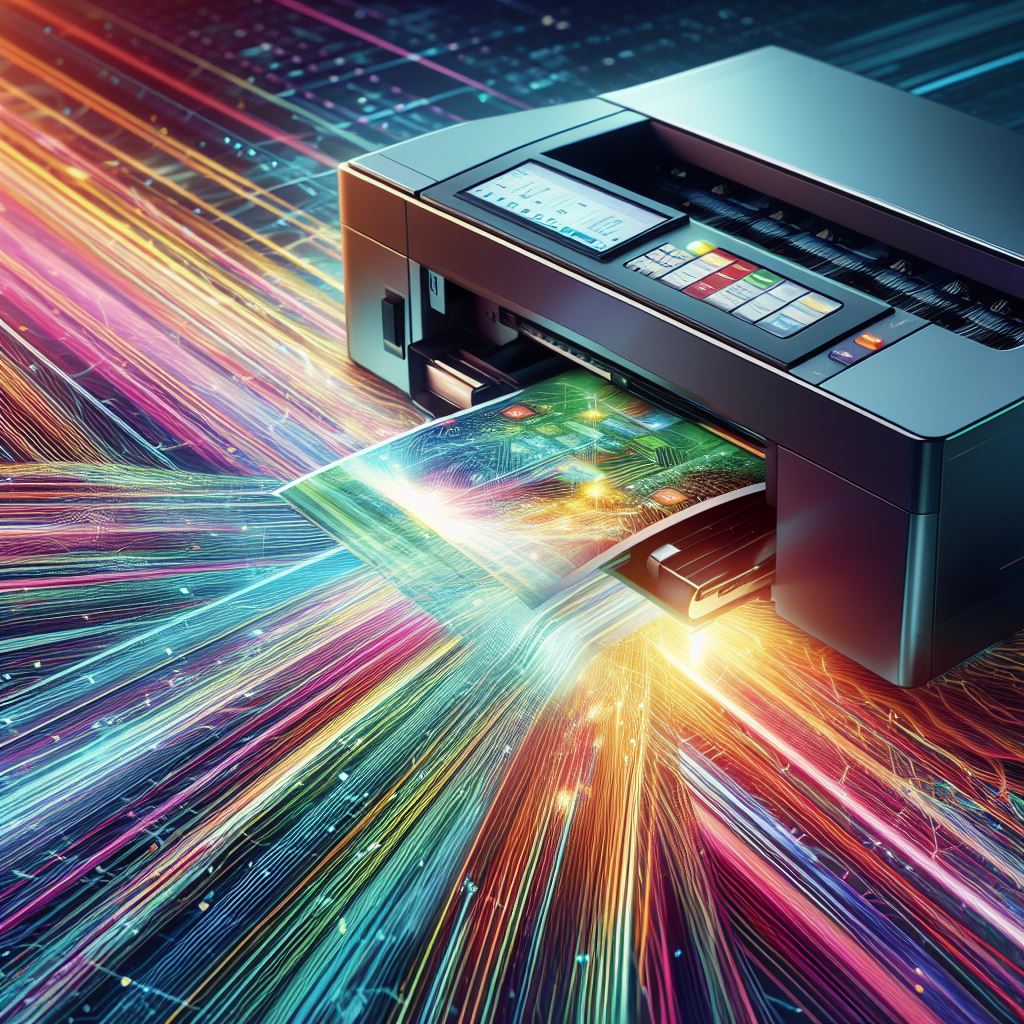
Laser printers use toner powder to create prints by melting the toner onto paper using heat. They are more expensive than inkjet printers upfront, but they are more economical in the long run due to their lower cost per page and faster print speeds. Laser printers are ideal for text-heavy documents and office use.
Ideal Use Cases
Laser printers are well-suited for the following use cases:
- Text-heavy documents: Laser printers produce sharp, high-quality text that is ideal for printing documents with a lot of text, such as reports, contracts, and legal documents.
- Office use: Laser printers are faster and more efficient than inkjet printers, making them ideal for office use where high-volume printing is required.
Pros and Cons
Pros
- Faster print speeds: Laser printers can print pages more quickly than inkjet printers, making them ideal for high-volume printing.
- Lower cost per page: Toner cartridges have a higher upfront cost than ink cartridges, but they last longer and have a lower cost per page, making laser printers more economical in the long run.
- High-quality text: Laser printers produce sharp, high-quality text that is ideal for printing text-heavy documents.
Cons
- Limited color printing: Laser printers are not ideal for printing high-quality color images and photos.
- Higher upfront cost: Laser printers are more expensive than inkjet printers upfront, making them less accessible for individuals and small businesses.
- Larger size: Laser printers are generally larger and heavier than inkjet printers, making them less portable and harder to move around.
By understanding the technology behind laser printers, their ideal use cases, and their pros and cons, individuals and businesses can make informed decisions when choosing a printer that aligns with their specific printing needs and preferences.
3. All-in-One Printers
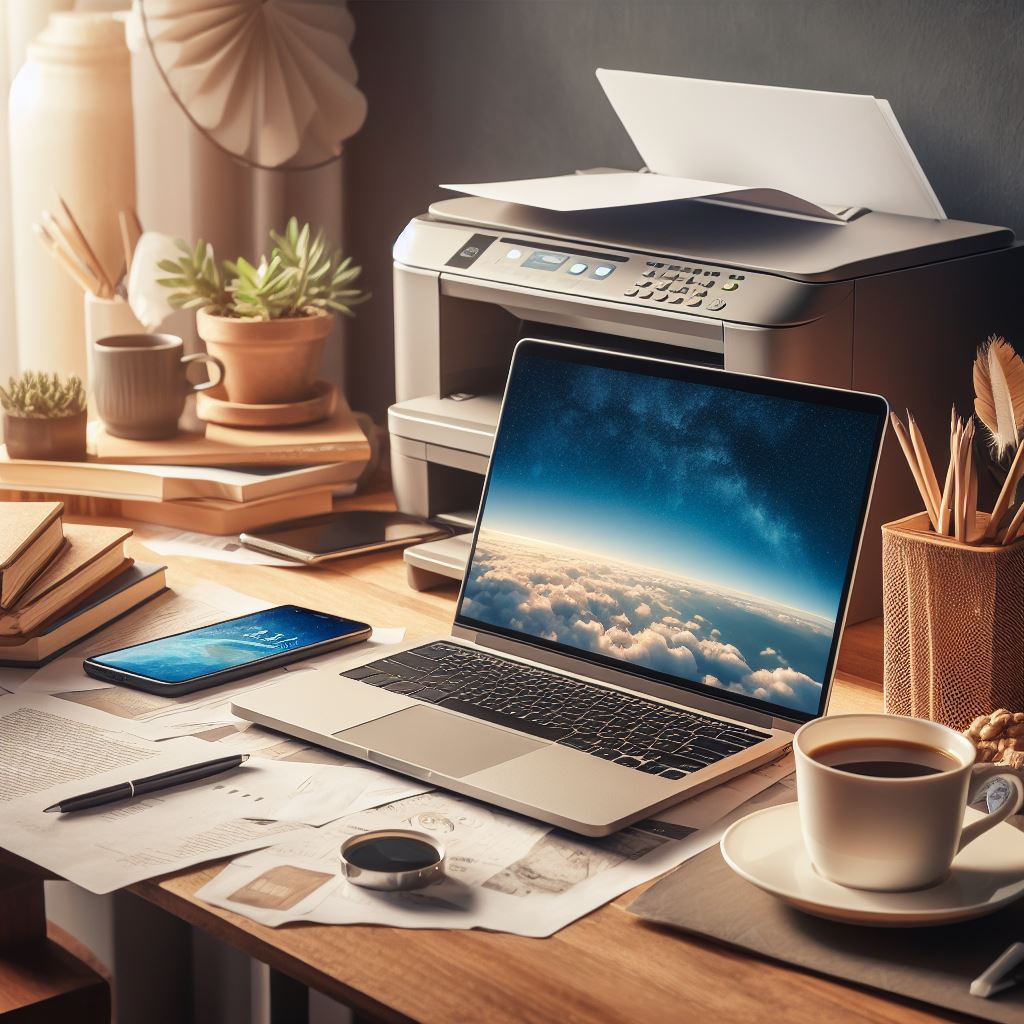
All-in-one printers, also known as multifunction printers, combine printing, scanning, copying, and sometimes faxing capabilities into a single machine, offering versatility and convenience for various printing needs. They are recommended for home offices and small businesses, providing a space-saving and cost-effective solution for multiple tasks.
These printers are designed to meet a wide range of printing needs, from everyday document printing to high-quality photo printing and scanning. They offer the following benefits:
- Space-saving: All-in-one printers consolidate multiple functions into a single device, saving space and reducing the need for separate machines for printing, scanning, and copying.
- Cost-effective: By combining multiple functions, all-in-one printers offer cost savings compared to purchasing individual devices for printing, scanning, and copying.
- Versatility: All-in-one printers are versatile and can handle various tasks, making them suitable for a diverse range of printing needs in home offices and small businesses.
For more detailed information and reviews on specific all-in-one printers, you can refer to online retailers such as Staples, Walmart, Amazon, and Office Depot, as well as review websites like RTINGS.com and The New York Times Wirecutter, which provide comprehensive insights and recommendations for the best all-in-one printers available in the market
4. Photo Printers
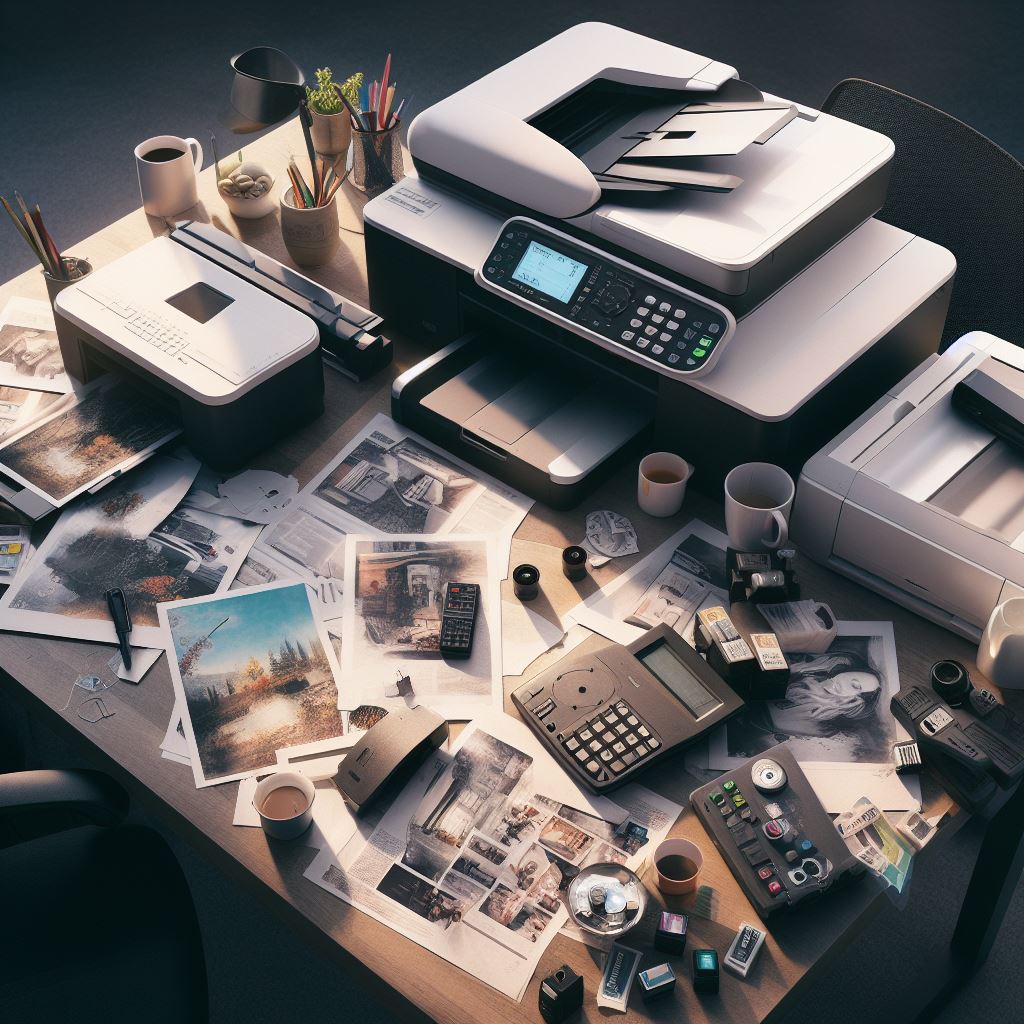
Pros and Cons of Photo Printers
Photo printers are dedicated to high-quality photo printing and are particularly ideal for photography enthusiasts. Here are the pros and cons of using photo printers:
Pros
- Affordability: Photo printers have become more affordable, allowing individuals to have them in their own homes, thanks to advances in inkjet and laser technologies.
- Portability: Some photo printers offer portability, allowing users to print photos on the go, making them convenient for events or parties.
- Quality: They provide high-quality prints, often with vivid colors and sharp details, making them suitable for professional and personal use.
- Instant printing: Some photo printers offer instant printing, allowing users to have physical copies of their photos immediately.
- Value: Printed photos are often perceived to hold more value and can make great gifts for family and friends.
Cons
- Cost: The cost of ink and specialized photo paper for high-quality printing can be expensive, impacting the overall cost of printing photos at home.
- Limited functionality: Photo printers are primarily designed for printing photos and may lack the features and capabilities of regular printers, such as scanning or copying.
- Print speed: Photo printers may have slower printing speeds due to the higher resolution and quality requirements for photo printing.
- Maintenance: Photo printers often require regular maintenance to ensure optimal print quality, which can add to the overall cost and effort of maintaining the printer.
- Longevity: The prints produced by photo printers may not last as long as those produced by traditional printers, as the colors may fade or deteriorate over time6.
Understanding the pros and cons of photo printers can help individuals make informed decisions about whether to invest in a photo printer for their specific printing needs and preferences.
5. 3D Printers
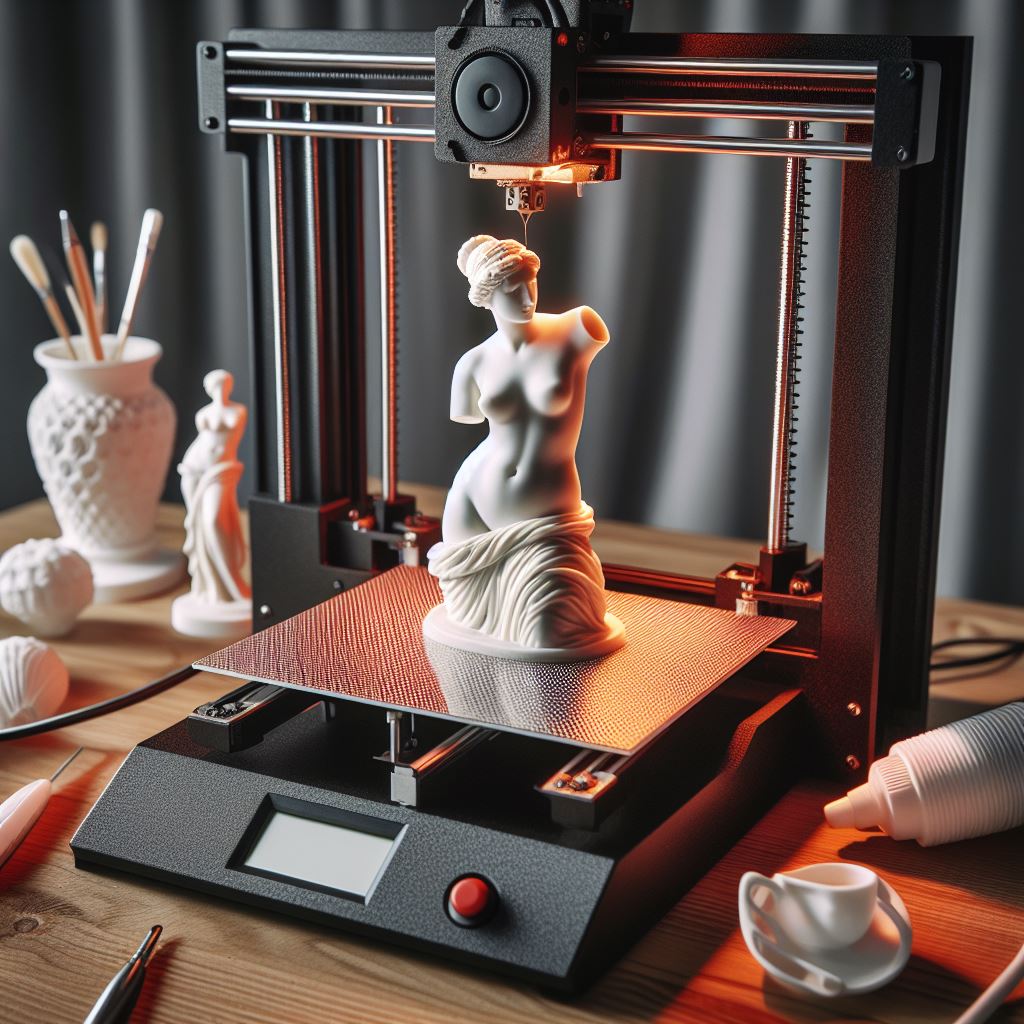
Basic Explanation of 3D Printing Technology
3D printing, also known as additive manufacturing, is a process that creates three-dimensional objects by adding material layer by layer. It uses various technologies, such as Fused Deposition Modeling (FDM) and Stereolithography (SLA), to build parts out of a wide range of plastics and metals. This technology offers a wide range of advantages, allowing for rapid adoption across various manufacturing industries.
Ideal Use Cases
3D printing is ideal for the following use cases:
- Prototyping: 3D printing allows for the rapid and cost-effective production of prototypes, enabling designers and engineers to test and iterate their designs before mass production.
- DIY projects: It provides individuals with the ability to create custom parts, components, and prototypes for various do-it-yourself (DIY) projects, hobbies, and small-scale manufacturing.
Pros and Cons
Pros
- Freedom of design: 3D printing enables the production of complex geometries that traditional manufacturing methods may struggle with, offering design flexibility and innovation.
- Reduced material waste: Additive manufacturing processes like 3D printing produce less waste compared to traditional subtractive methods, leading to cost savings and environmental benefits.
- Rapid prototyping: It dramatically reduces the time from conception to implementation, allowing for faster testing and iteration of product ideas and engineering solutions.
- Customization: 3D printing allows for the creation of customized and personalized products, catering to specific individual or industry needs.
Cons
- Post-processing: Most 3D printed parts require some form of post-processing, adding time and effort to the production process.
- Limited materials: While 3D printing can create items in a selection of plastics and metals, the available selection of raw materials is not exhaustive, limiting material options for certain applications.
- Regulatory challenges: 3D printing may present regulatory challenges, especially in industries with strict quality and safety standards.
- Large quantities: 3D printing doesn't always work well for large projects, as it may not be as efficient as traditional manufacturing methods for mass production.
Understanding the basic principles, ideal use cases, and the pros and cons of 3D printing can help individuals and businesses evaluate whether this technology aligns with their specific manufacturing and prototyping needs.
Considerations for Choosing a Printer
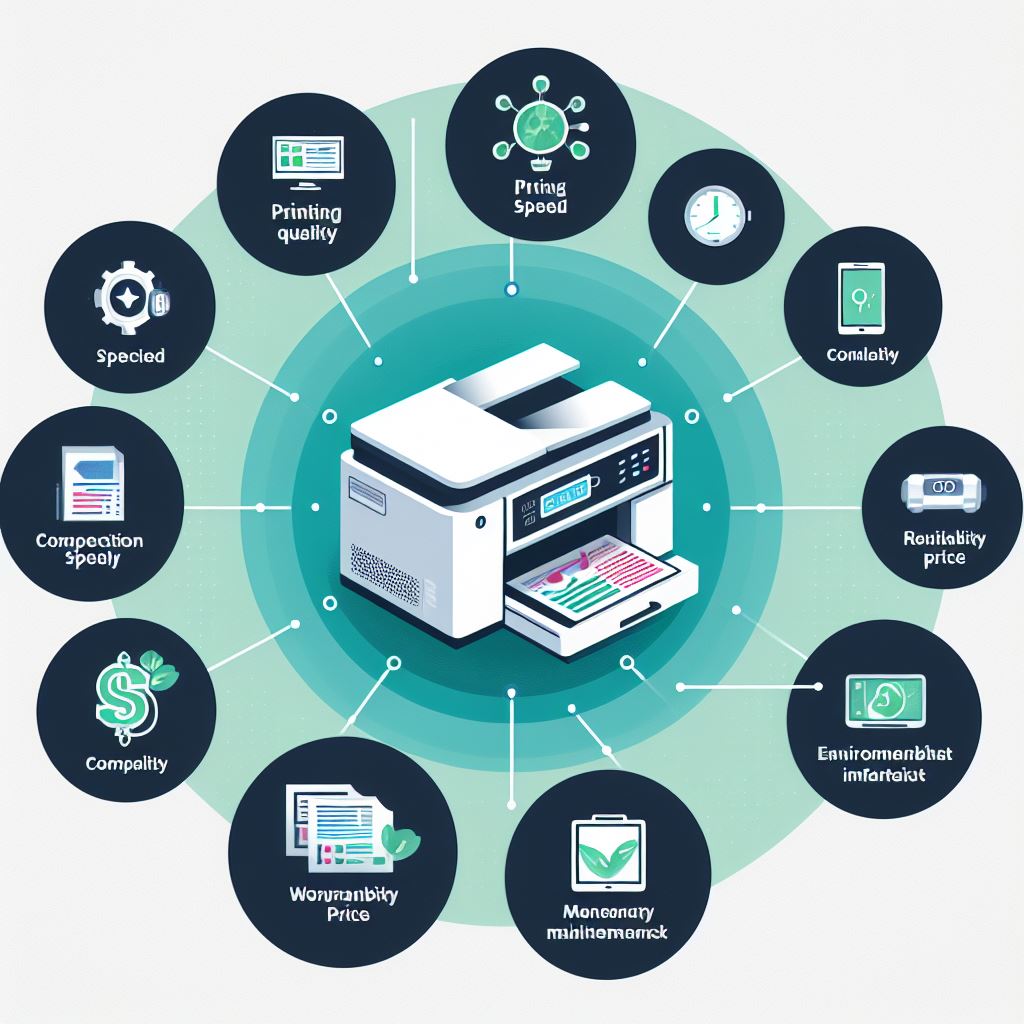
1. Intended Use
When choosing a printer, the intended use is a crucial factor to consider. The following are some examples of how the intended use affects the choice of printer type:
Home Use
- Inkjet printers are versatile and cost-effective, making them suitable for everyday printing needs in households, including text documents, graphics, and occasional photo printing.
- All-in-one printers are convenient and space-saving, combining printing, scanning, and copying capabilities into a single machine.
Office Use
- Laser printers are faster and more efficient than inkjet printers, making them ideal for office use where high-volume printing is required.
- All-in-one printers are also suitable for office use, providing a space-saving and cost-effective solution for multiple tasks.
Creative Projects
- Inkjet printers are ideal for producing high-quality photo prints, making them popular among photography enthusiasts and professionals.
- 3D printers are ideal for prototyping and DIY projects, allowing for the rapid and cost-effective production of prototypes and custom parts.
By assessing the intended use of the printer, individuals and businesses can determine which printer type aligns with their specific printing needs and preferences. It is also important to consider other factors such as upfront and long-term costs, maintenance requirements, printing speed, and printing quality.
2. Print Speed and Volume
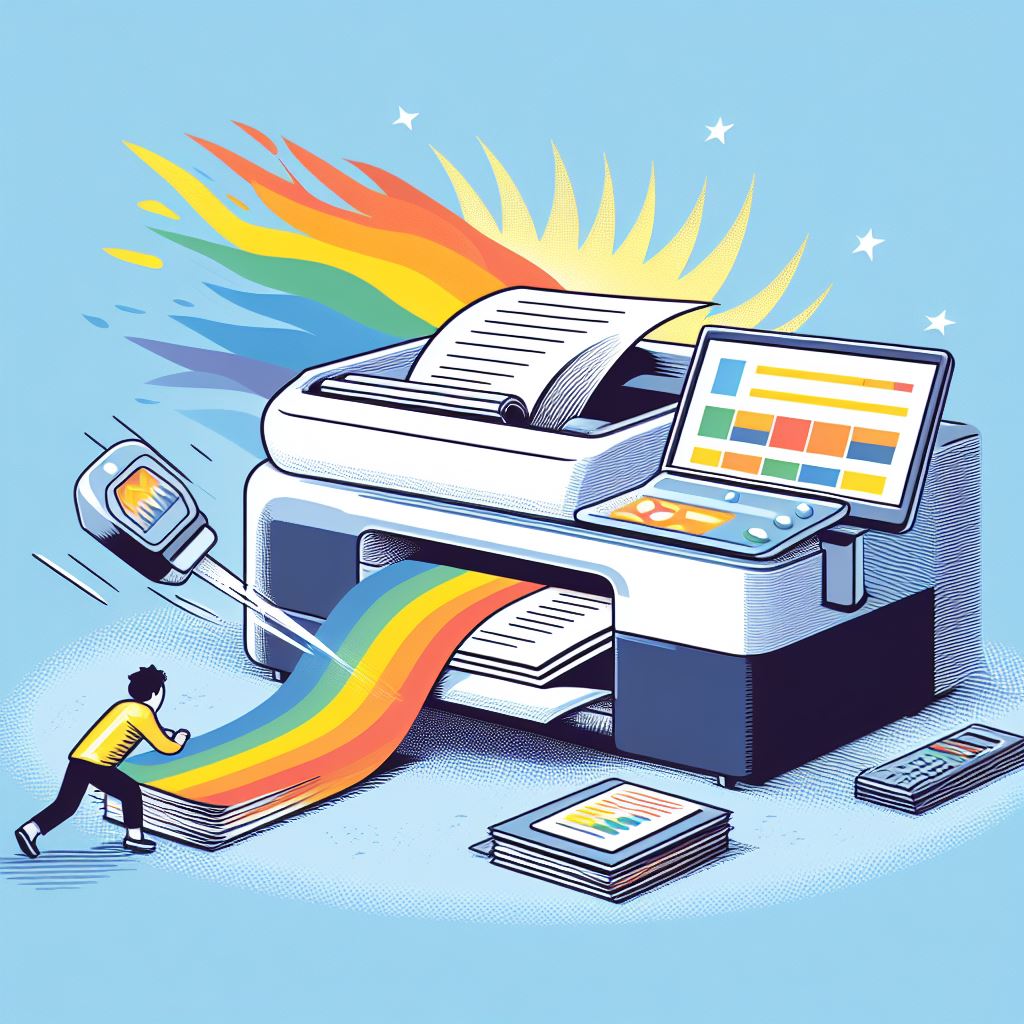
Understanding pages per minute (PPM) is crucial when evaluating printer speed. Here's how printer speed is measured and how to match it to your needs:
Measuring Printer Speed
- Pages Per Minute (PPM): Printers typically measure speed by counting the number of standard pages that can successfully be printed in a single minute. This metric is known as pages per minute (PPM) and is used to measure speed on nearly every inkjet printer, multi-function printer, laser printer, and other types of printer.
- 3D Printers: Unlike traditional printers, 3D printers do not use PPM to measure speed due to the nature of their design. Instead, 3D printing speed is often measured in linear speed (mm/s) or volumetric flow (mm3/s) for extrusion-based 3D printers.
Matching Printer Speed to Your Needs
- Home and Small Office Use: For home and small office use, inkjet printers with an average speed of 5 to 10 PPM are suitable for low to medium printing volumes. All-in-one printers can also be a convenient choice for these environments, offering a combination of printing, scanning, and copying capabilities.
- Medium to High-Volume Printing: Laser printers are ideal for medium to high-volume printing needs, with speeds averaging around 20 to 30 PPM. They are well-suited for office environments where fast and efficient printing is essential.
- 3D Printing: When considering 3D printing, the speed is measured in linear speed (mm/s) or volumetric flow (mm3/s). The choice of speed depends on the specific requirements of the 3D printing project, such as the complexity of the design and the desired print quality.
By understanding how printer speed is measured and matching it to specific printing needs, individuals and businesses can make informed decisions when selecting a printer that aligns with their volume and speed requirements.
3. Print Quality
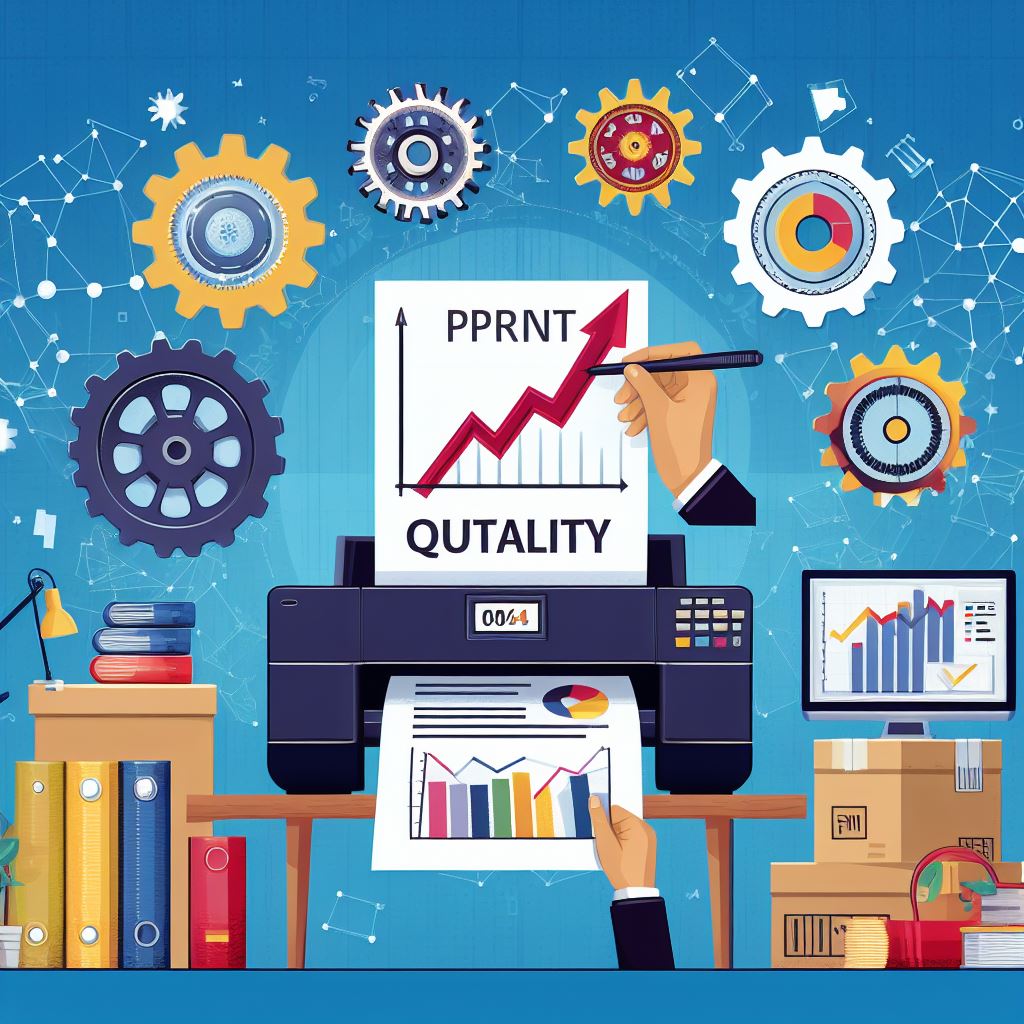
Resolution and DPI Explained
Resolution and DPI (Dots Per Inch) play a crucial role in determining print quality. Here's an explanation of these terms and their importance for different purposes:
- Resolution: The resolution of an image refers to the number of pixels it contains. High-resolution images have more pixels, providing more detail and sharper, clearer prints. For a print to be considered high quality, it needs to have a certain number of pixels per inch (PPI), with 300 PPI often cited as the standard for high-quality prints.
- DPI: DPI stands for Dots Per Inch and is relevant for printers that print an image by placing a series of dots to create the image. PPI is for the digital image itself, and DPI is for the printed version. Higher DPI settings generally result in finer details and smoother color transitions in printed images.
Importance of Print Quality for Different Purposes
- Photography and Creative Projects: High print quality is essential for photography and creative projects as it ensures that the details and colors in the images are accurately reproduced. This is particularly important for large prints where low-resolution images can appear pixelated or blurry.
- Legal Documents: Print quality is crucial for legal documents as it can affect the accuracy and reliability of the document. Poor print quality can lead to issues such as illegible writing, incorrect information, and miscommunication, potentially causing costly misunderstandings or disputes.
- Business and Marketing: High-quality printing is crucial for businesses looking to create a professional image, enhance marketing materials, and improve communication. It plays a critical role in branding and marketing, communication, and advertising, contributing to the overall success of a business.
Understanding resolution, DPI, and the importance of print quality for different purposes is essential for achieving the desired results in various printing applications. It is important to consider these factors when selecting a printer and when preparing images and documents for printing.
4. Connectivity Options
Wireless vs. Wired Connections for Printers
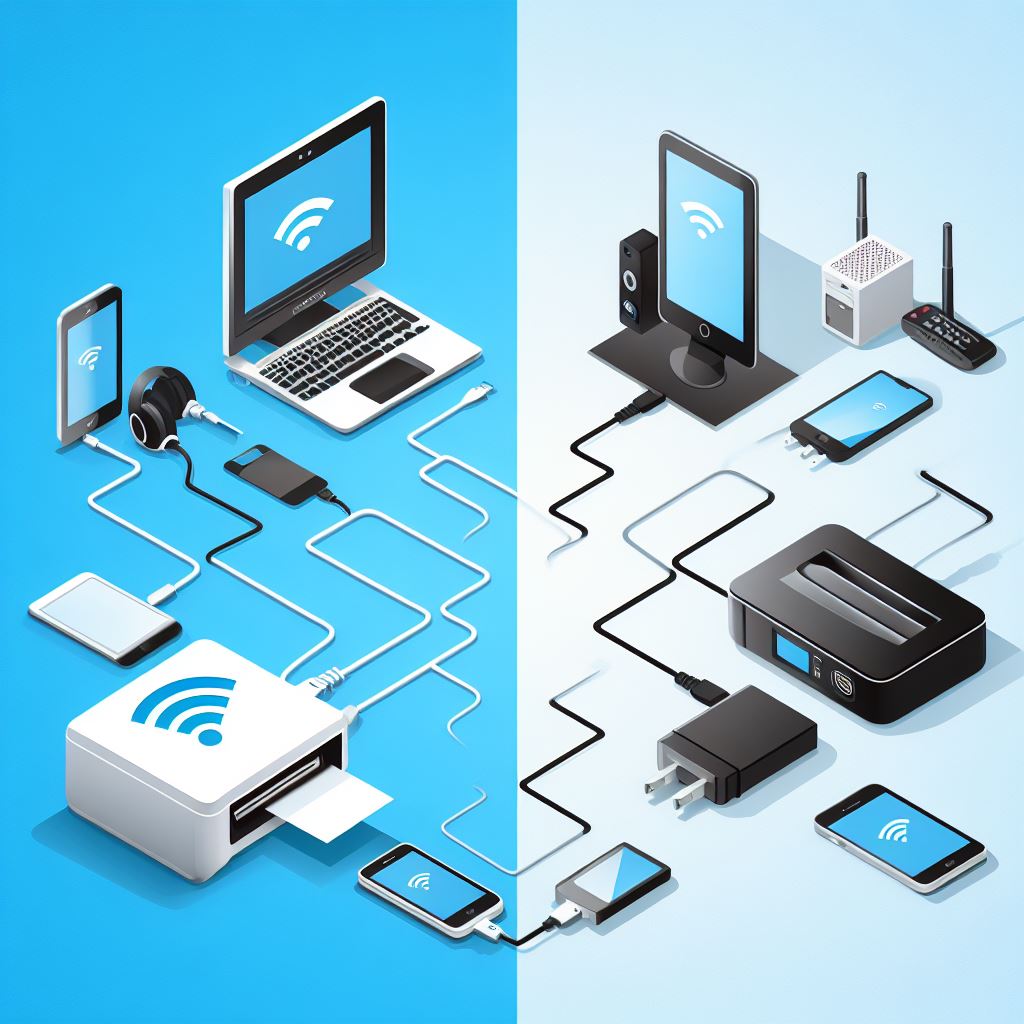
When considering printer connectivity options, it's important to understand the differences between wireless and wired connections, as well as the mobile printing capabilities. Here's a summary:
Wireless Connections
- Wi-Fi: Allows for a wireless connection between the printer and the local area network (LAN), providing added flexibility and mobility, as you can connect to the printer from any location within the coverage area.
- Bluetooth: Enables a wireless connection between the printer and a computer or device with Bluetooth capabilities, offering convenience and flexibility for direct printing.
- NFC: Near Field Communication (NFC) allows for wireless communication between devices in close proximity, enabling quick and easy printing from NFC-enabled devices.
- Cloud Printing: Cloud printing enables users to print from anywhere with an internet connection, providing seamless access to printers from various devices and locations.
Wired Connections
- USB: Provides a direct connection between the computer and the printer, offering a reliable and straightforward method for printing.
- Ethernet: Allows for a direct connection between the printer and the local area network (LAN) through an Ethernet cable, offering faster speeds and stable connectivity for multiple users.
Mobile Printing Capabilities
- Some printers offer both wired and wireless connectivity options, providing users with the flexibility to switch between methods based on their current requirements.
- Printers can be set up to be used in both wired and wireless networks, but only one of the connection methods can be active at a time. When the wireless setting is enabled, the wired (Ethernet) setting is disabled, and vice versa.
Understanding the available connectivity options, including wireless (Wi-Fi, Bluetooth, NFC, Cloud Printing) and wired (USB, Ethernet), as well as the mobile printing capabilities, allows individuals and businesses to choose the most suitable printer connectivity method based on their specific requirements and preferences.
5. Paper Handling
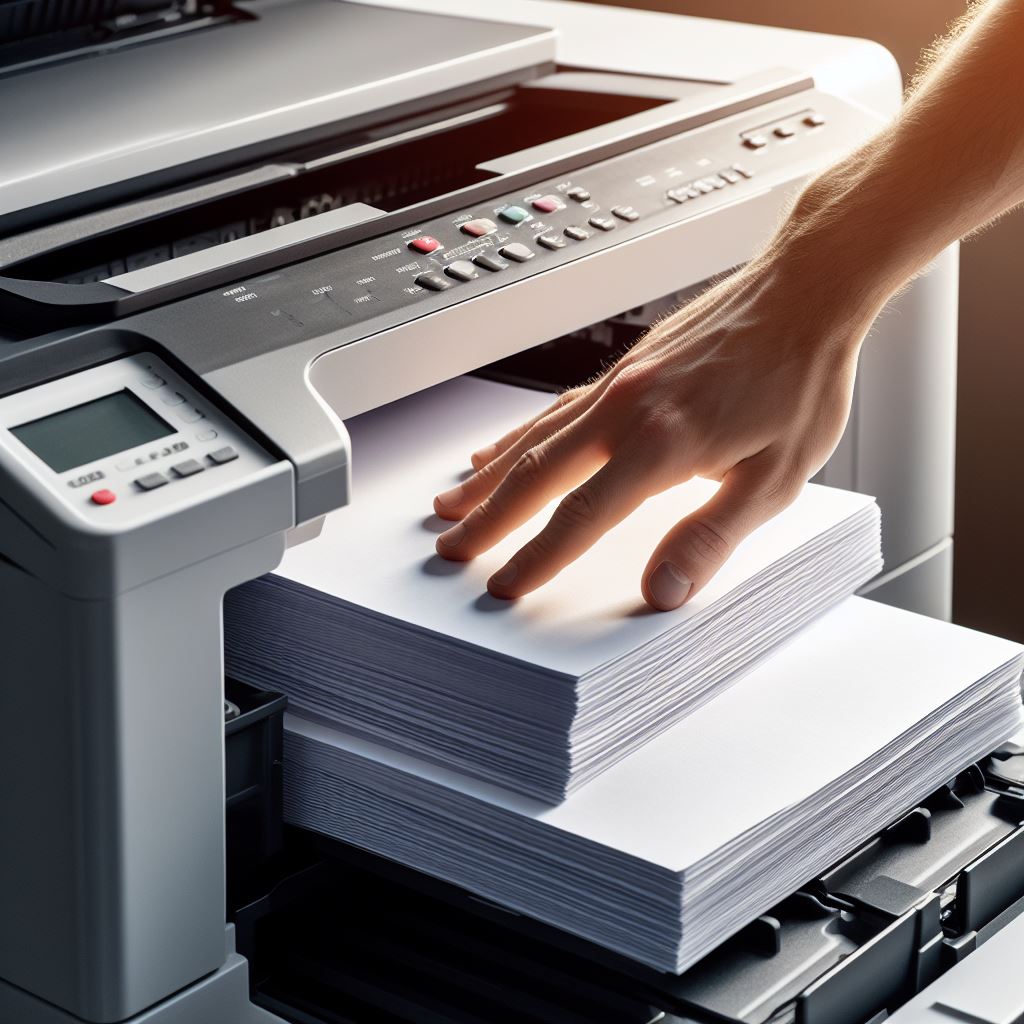
When it comes to paper handling, understanding different paper sizes and types, as well as specialty paper considerations, is essential for selecting the right printer. Here's it’s breakdown:
Different Paper Sizes and Types
- Standard Paper Sizes: Printers should support standard paper sizes such as letter (8.5 x 11 inches), legal (8.5 x 14 inches), and tabloid (11 x 17 inches) to accommodate common printing needs.
- Specialty Paper: Some printers are capable of handling specialty paper types such as envelopes, cardstock, labels, and glossy photo paper, providing versatility for various printing applications.
- Paper Handling Equipment: This category includes cutting tools, booklet makers, and paper drills, which are used to prepare paper for printing and other applications.
Specialty Paper Considerations
- Coated Paper: Printers capable of handling coated paper are suitable for producing high-quality marketing materials, brochures, and images with enhanced color vibrancy and sharpness.
- Envelopes and Labels: Printers with specific paper paths and settings for envelopes and labels ensure accurate feeding and printing on these specialty media types.
- Photo Paper: For photo printers, the ability to handle various sizes and finishes of photo paper is crucial for producing high-quality photo prints.
Understanding the capabilities of a printer in handling different paper sizes, types, and specialty media is essential for ensuring that it meets specific printing requirements, whether for standard office documents, marketing materials, or high-quality photo prints.
Features to Look for

1. Duplex Printing
Duplex printing is a feature that allows a printer to print on both sides of a paper automatically or manually. Here are the key features to look for when considering a printer with duplex printing capability:
- Automatic Duplex Printing: This feature allows the printer to print on both sides of the paper without the need for manual intervention. It is a convenient and time-saving option that can significantly reduce paper usage and costs.
- Manual Duplex Printing: Some printers may require manual flipping of the paper to print on both sides. While this may require a bit of extra effort, it still offers the cost-saving and environmental benefits of duplex printing.
Duplex Printing Benefits:
- Cost-saving: Duplex printing reduces paper consumption, cutting down on costs associated with paper usage.
- Printer Compatibility: When looking for a printer with duplex printing, it's important to check the model specifications to ensure that it has the duplex printing feature.
- Manufacturers Offering Duplex Printing: Most printer manufacturers offer models with duplex printing capabilities, providing a range of options for users to choose from.
By considering these features, individuals and businesses can make informed decisions when selecting a printer with duplex printing capabilities, taking advantage of the cost-saving, environmental, and convenience benefits it offers.
2. Scanner and Copier Features
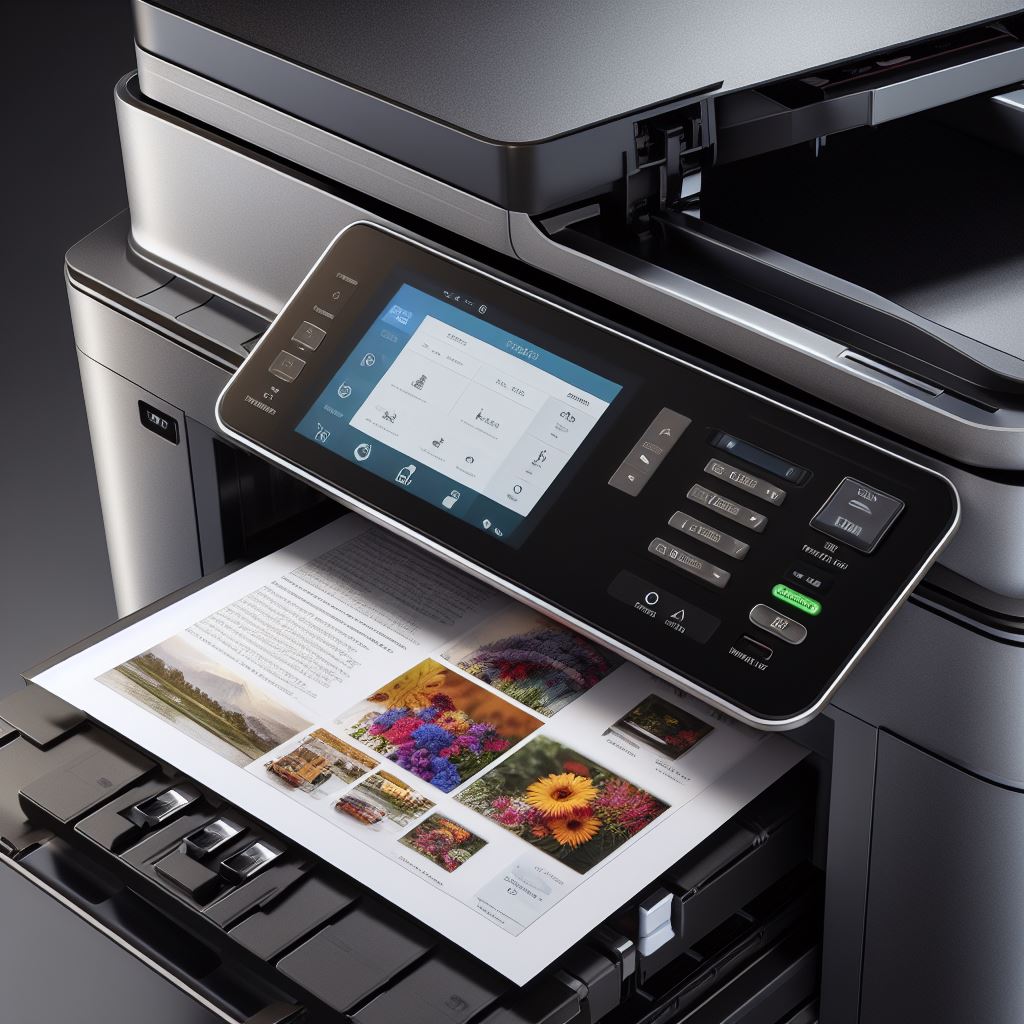
The environmental benefits of duplex printing are significant and contribute to sustainability and cost-effectiveness. Here are the key environmental advantages of duplex printing:
- Reduced Paper Consumption: Duplex printing allows for the utilization of both sides of the paper, effectively cutting paper usage in half. This reduction in paper consumption directly contributes to conservation of natural resources and minimizes the environmental impact associated with paper production.
- Lower Carbon Footprint: By reducing paper usage, duplex printing helps in lowering the carbon footprint associated with paper manufacturing, transportation, and disposal. This aligns with sustainability goals and reduces the environmental impact of printing activities.
- Cost Savings: Duplex printing not only benefits the environment but also leads to cost savings for individuals and businesses. By using less paper, organizations can reduce their paper procurement costs and minimize waste disposal expenses.
- Conservation of Forests: With reduced paper consumption, duplex printing contributes to the conservation of forests and natural habitats. It aligns with sustainable forestry practices and supports efforts to preserve biodiversity.
- Energy Efficiency: Duplex printing indirectly contributes to energy efficiency by reducing the overall demand for paper production and disposal processes, which are energy-intensive activities.
By embracing duplex printing, individuals and organizations can actively participate in environmentally responsible printing practices, reduce their ecological footprint, and contribute to a more sustainable future.
3. Touchscreen Displays
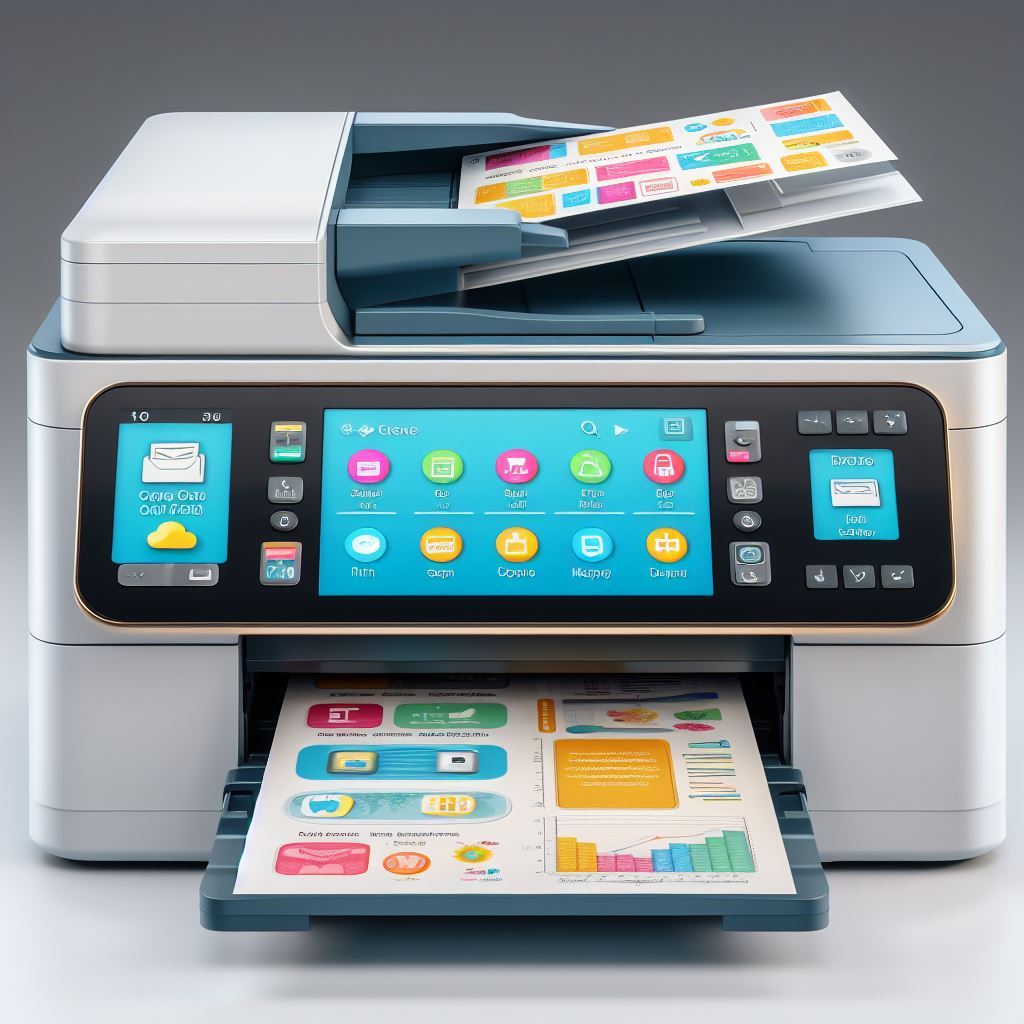
Touchscreen displays offer user-friendly interfaces and accessibility features that make them easy to use for a wide range of individuals. However, some people with physical disabilities may face barriers when using touch screens. Here are some key points to consider:
- Accessibility: Touch screens can present barriers to people with physical disabilities who are unable to touch the device. However, touch screens have been used as assistive technology for many years, providing an alternative to standard input devices for users who need access to standard applications. There are also various tools and features available to improve the physical accessibility of touch screens for people with motor disabilities.
- Ease of Use: Touch screens are designed to provide user-friendly, intuitive computer access without requiring a keyboard and mouse. They are particularly useful for people who experience difficulty using keyboards and mice because of physical or cognitive disabilities.
In fact, touch screens have been used in education to facilitate interaction between learners and content to be learned. - BrushLens Technology: BrushLens technology is a new development that could make touch screens accessible to everyone, including people who are blind or lack fine control of their fingers. This technology uses a camera and a brush to track the user's finger movements, allowing them to interact with the touch screen without actually touching it.
- Special Needs Touch Screens: There are also touch screens designed specifically for children and individuals with special needs or disabilities. These touch screens are designed to be easy to use and provide a fun and engaging learning experience.
In summary, touch screens offer user-friendly interfaces and accessibility features that make them easy to use for a wide range of individuals. While they may present barriers to some people with physical disabilities, there are various tools and features available to improve their physical accessibility. Additionally, new technologies like BrushLens are being developed to make touch screens accessible to everyone.
4. Energy Efficiency
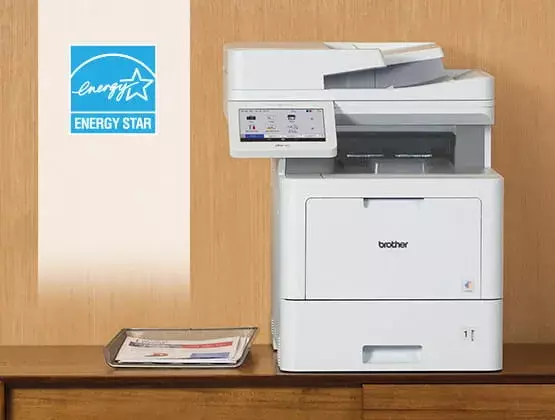
Energy efficiency is a crucial consideration when looking for appliances and devices. Here are some insights on energy efficiency, including Energy Star ratings and power-saving features:
- Energy Star Ratings: When looking for energy-efficient appliances, it's important to consider products with the Energy Star label. Energy Star is a program by the U.S. Environmental Protection Agency and the U.S. Department of Energy that helps consumers identify energy-efficient products.
Appliances with the Energy Star label meet strict energy efficiency guidelines set by these agencies, ensuring that they consume less energy compared to standard models. - Sleep Mode and Power-Saving Features: Many modern appliances, including printers, scanners, and copiers, come with sleep mode and power-saving features. These features allow the devices to enter a low-power state when not in use, reducing energy consumption.
For example, printers with automatic sleep mode can significantly reduce energy usage when idle, contributing to overall energy efficiency. - Other Energy-Saving Tips: In addition to choosing energy-efficient appliances, there are various other ways to conserve energy and reduce electricity costs. These include using LED light bulbs, installing programmable thermostats, and using smart power strips to eliminate standby power usage.
Additionally, setting thermostats at optimal temperatures and using energy-efficient electronics can contribute to overall energy savings.
By considering Energy Star ratings and looking for appliances with power-saving features, individuals and businesses can make informed choices to reduce energy consumption and contribute to environmental sustainability.
Budget Considerations

When considering budget constraints and long-term costs, including ink or toner expenses, duplex printing presents a compelling case for cost savings and environmental benefits.
Cost Savings with Duplex Printing:
- According to the U.S. Navy study, the estimated savings from printing duplex is about one cent per page.
- Implementing duplex printing as the default setting can lead to significant cost savings. For example, setting printing defaults to duplex printing can save a business $1,440 a year and 150,000 extra pieces of paper from the landfill or recycling facility.
- Duplex printing saves 50% on media costs in just two hours, reducing paper waste and saving money.
Long-Term Cost Reduction:
-
- Duplex printing reduces paper consumption by half, leading to long-term cost reduction in paper procurement and disposal expenses.
- By cutting print expenses with duplex printing, businesses can allocate the saved funds towards other needs such as ordering more equipment or improving office furnishings.
Considerations for Printer Selection:
-
- Most printers made within the past few years already include duplex printing features, and some have faster processes to perform the duplex printing almost as quickly as printing single-sided sheets.
- Purchasing a new duplexing printer may make more sense from an expense and maintenance perspective, especially for medium-quality office-ready printers.
- Duplex printing reduces the amount of paper used and the energy required, contributing to environmental conservation and sustainability.
- Utilizing both sides of a sheet of paper through duplex printing can cut the amount of paper consumed by half, aligning with sustainability goals.
In summary, duplex printing offers substantial cost savings and environmental benefits, making it a practical choice for balancing features with budget constraints and reducing long-term ink or toner expenses.
Frequently Asked Questions (FAQs)
1. How often should I replace ink or toner cartridges?
The frequency of replacing ink or toner cartridges depends on the printer model, usage, and the type of cartridges used. Generally, ink cartridges need to be replaced more frequently than toner cartridges.
A good rule of thumb is to replace cartridges when the print quality starts to degrade or when the printer prompts you to do so.
2. What's the difference between ink and toner?
Ink is a liquid used in inkjet printers, while toner is a powder used in laser printers. Inkjet printers use liquid ink that is sprayed onto the paper through tiny nozzles, while laser printers use toner that is melted onto the paper using heat.
3. Can I use third-party cartridges with my printer?
Yes, you can use third-party cartridges with your printer. However, there are some risks associated with using third-party cartridges, such as poor print quality, damage to the printer, and voiding the printer's warranty.
It's important to do your research and buy from reputable suppliers to ensure that you get high-quality cartridges that are compatible with your printer
4. How do I maintain my printer for optimal performance?
To maintain your printer for optimal performance, regularly clean the printer, use high-quality ink cartridges, prevent moisture buildup, update printer drivers, and schedule maintenance tasks.
- Regular cleaning is essential to prevent dust, debris, and ink residue from accumulating inside your printer.
- Use high-quality ink cartridges to ensure optimal performance and longevity of the printer.
- Prevent moisture buildup by storing the printer in a cool and dry area.
- Regularly check for firmware and driver updates and download and install the latest drivers compatible with your printer model and operating system.
Schedule routine maintenance tasks, including cleaning, updating printer drivers, and checking for firmware updates. By following these guidelines, you can ensure that your printer will continue to produce high-quality prints for years to come.
5. What is the average lifespan of a printer?
The average lifespan of a printer is typically around three to five years, with proper maintenance and care potentially extending its longevity. However, the lifespan can vary based on factors such as usage, maintenance, and the specific make and model of the printer.
Laser printers generally have a longer lifespan compared to inkjet printers, with inkjet printers typically lasting around three years or less, while laser printers can often last five years or more.
Factors Affecting Printer Lifespan:
- Maintenance: Regular cleaning and upkeep can contribute to prolonging a printer's lifespan.
- Usage: Heavy usage may lead to more wear and tear, potentially impacting the printer's longevity.
- Make and Model: Different printer models may have varying lifespans based on their design and build quality.
It's important to consider the signs that may indicate the need for a new printer, such as frequent mechanical issues, declining print quality, or excessive repair costs. These signs can help determine when it's time to consider an upgrade or replacement.
In summary, while the average lifespan of a printer is around three to five years, proper maintenance, usage, and the specific make and model of the printer can influence its longevity. Understanding these factors can help users make informed decisions about printer care and potential replacements.
6. Are there any security considerations with wireless printers?
Wireless printers pose security risks, potentially serving as entry points for cyberattacks. Vulnerabilities in wireless printers can lead to unauthorized access, data theft, and network breaches.
Hackers can exploit these vulnerabilities to gain access to sensitive data and spread malware.
To secure wireless printers, it's crucial to implement strong network security measures, such as using encryption protocols, enabling printer security features, and regularly updating firmware.
Additionally, monitoring printer logs for unusual activities and securing home Wi-Fi networks are essential steps to mitigate security risks.
By following best practices and implementing robust security measures, the risk of security breaches associated with wireless printers can be significantly reduced.
7. What is the significance of PPM in printers?
PPM stands for “pages per minute” and is a measurement standard used to determine how fast a printer can print.
It is an important factor to consider when comparing printers and determining which one is best suited for your needs. The PPM rating on a printer gives you the speed at which a particular printer can print a page of text in black ink.
It does not tell you how quickly the printer can print a page of text and graphics. When comparing PPM between printers, it is important to note what quality the pages are being printed at; low-quality prints are faster than high-quality prints.
The PPM for each printer is different, and it is generally a little slower for color printing than for black ink printing.
By understanding PPM, you can make an informed decision when purchasing a printer that meets your printing needs.
8. How do I troubleshoot common printer issues?
Troubleshooting common printer issues involves addressing problems such as paper jams, slow printing, and connectivity issues. Here are some solutions:
- Paper Jams: Clear any jammed paper from the printer, ensuring that no torn pieces remain. Check the paper path for any obstructions.
- Slow Printing: Adjust the printer settings to optimize speed. Consider selecting the “Print Directly to the Printer” option in the printer properties to enhance printing speed.
- Connectivity Issues: Ensure that the printer is connected to the correct network and that the printer drivers are up to date. Troubleshoot USB connectivity issues by restarting the printer and computer.
- Print Quality Problems: If experiencing poor print quality, check the ink or toner levels, and ensure that the correct paper type is selected. Consider reinstalling the printer drivers if issues persist.
- Offline Printer: Verify the printer's connection to the network or computer. Restart the printer and check for any error messages.
By addressing these common printer issues, users can troubleshoot and resolve printing problems effectively.
9. What is the difference between dye-based and pigment-based inks?
Dye-based ink and pigment-based ink are two types of ink used in inkjet printers. Dye-based ink uses color substances that are dissolved in a liquid, while pigment-based ink uses small color particles that are held in a suspension.
Dye-based ink provides softer colors that look more vivid and brilliant than pigment-based ink. However, dye-based ink may come off when getting in contact with water unless printed on special coated label material.
Pigment-based ink is lighter in color than dye-based ink, but it is more water-resistant and produces a truer solid black than dye-based ink.
Pigment-based ink is also more lightfast, meaning it will not fade or discolor over time, whereas dye-based ink can fade over time from exposure to light.
Pigment-based ink is typically used by the professional market, while dye-based ink is more commonly used in lower-end or consumer-focused printers.
10. How do I choose the right paper for my printer?
When choosing the right paper for your printer, consider the following factors:
- Paper Type: There are various types of printer paper, including multipurpose, inkjet, laser, and specialty papers like photo paper and cardstock. Select the type that best suits your printing needs.
- Paper Weight: The weight of the paper affects its thickness and durability. Standard office printing typically uses 20 lb. paper, while heavier weights are suitable for presentations and marketing materials.
- Coated vs. Uncoated: Coated paper is ideal for vibrant color printing and photo reproduction, while uncoated paper is suitable for standard text documents.
- Color: Colored printer paper can add visual interest to documents and should complement the content being printed.
- Size: Ensure that the paper size matches the document or image dimensions to avoid printing issues.
- Compatibility: Consider your printer's specifications and ensure that the chosen paper type is compatible with your printer.
By considering these factors, you can select the right paper for your printer based on your specific printing requirements and preferences.
Conclusion
In conclusion, it's essential to consider key factors when selecting a printer, such as duplex printing capability, scanner and copier features, touchscreen displays, energy efficiency, and ink or toner expenses.
Duplex printing offers cost-saving and environmental benefits, while touchscreen displays provide user-friendly interfaces. Energy Star ratings and power-saving features contribute to energy efficiency. When maintaining a printer, regular cleaning, using high-quality ink cartridges, and scheduling maintenance tasks are crucial.
I encourage readers to make informed decisions by considering their specific needs and the features offered by different printers. By understanding the significance of PPM, the differences between dye-based and pigment-based inks, and how to choose the right paper for their printer, individuals can make well-informed choices.
For further assistance or recommendations on printer selection, maintenance, or troubleshooting, feel free to seek advice from reputable sources or consult with printer experts. Making informed decisions about printers can lead to enhanced productivity, cost savings, and environmental sustainability.
If you need further assistance or recommendations, don't hesitate to reach out for expert guidance.

Morgan Azhari, the owner of PrinterUpdate.net, is a dedicated expert in the field of printers, leveraging a wealth of experience and education to create a platform that passionately shares insights and solutions.
With a goal to enhance the printer user experience, my vision for the website is to provide valuable content, making a positive impact on individuals navigating the complexities of printers.
